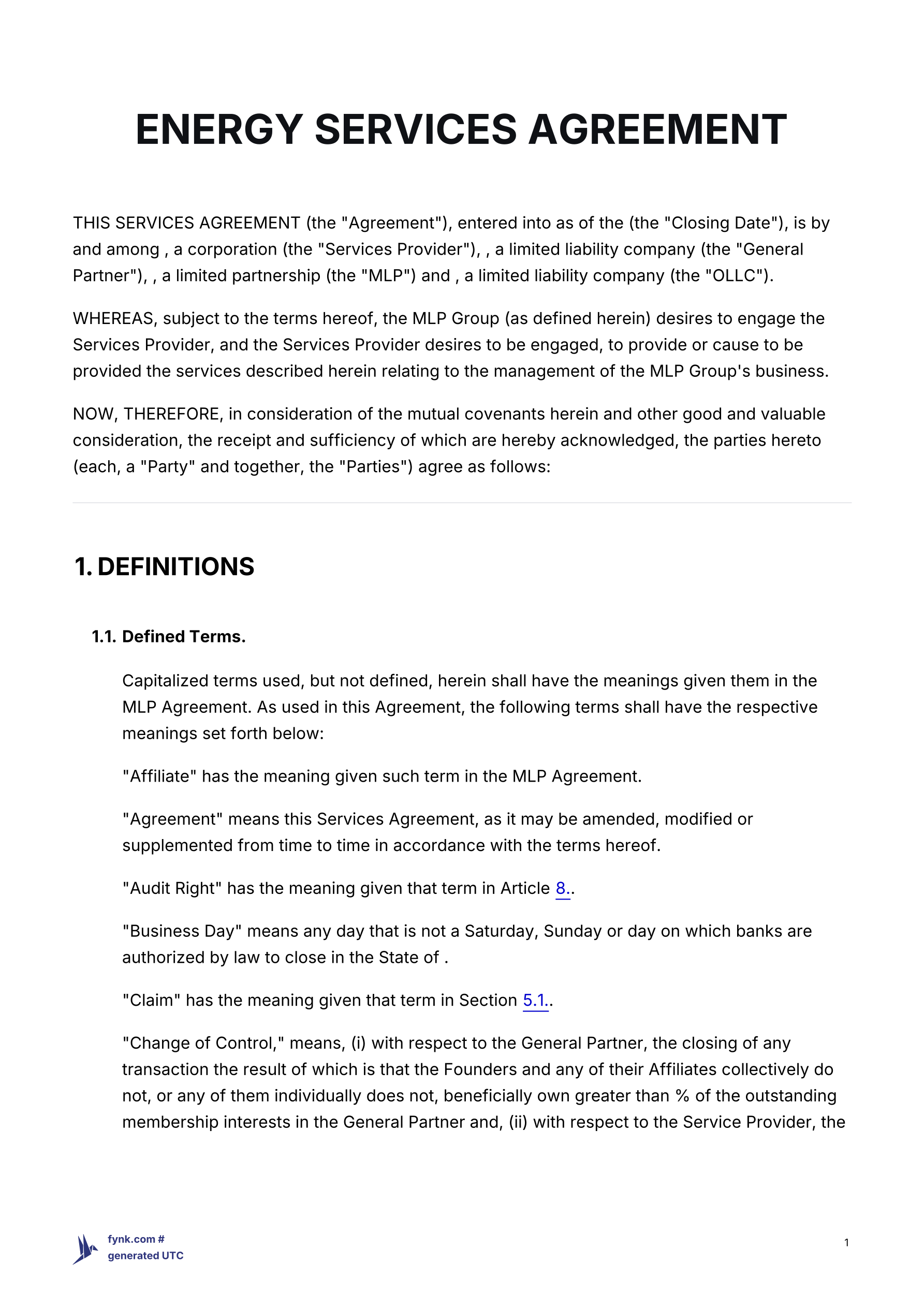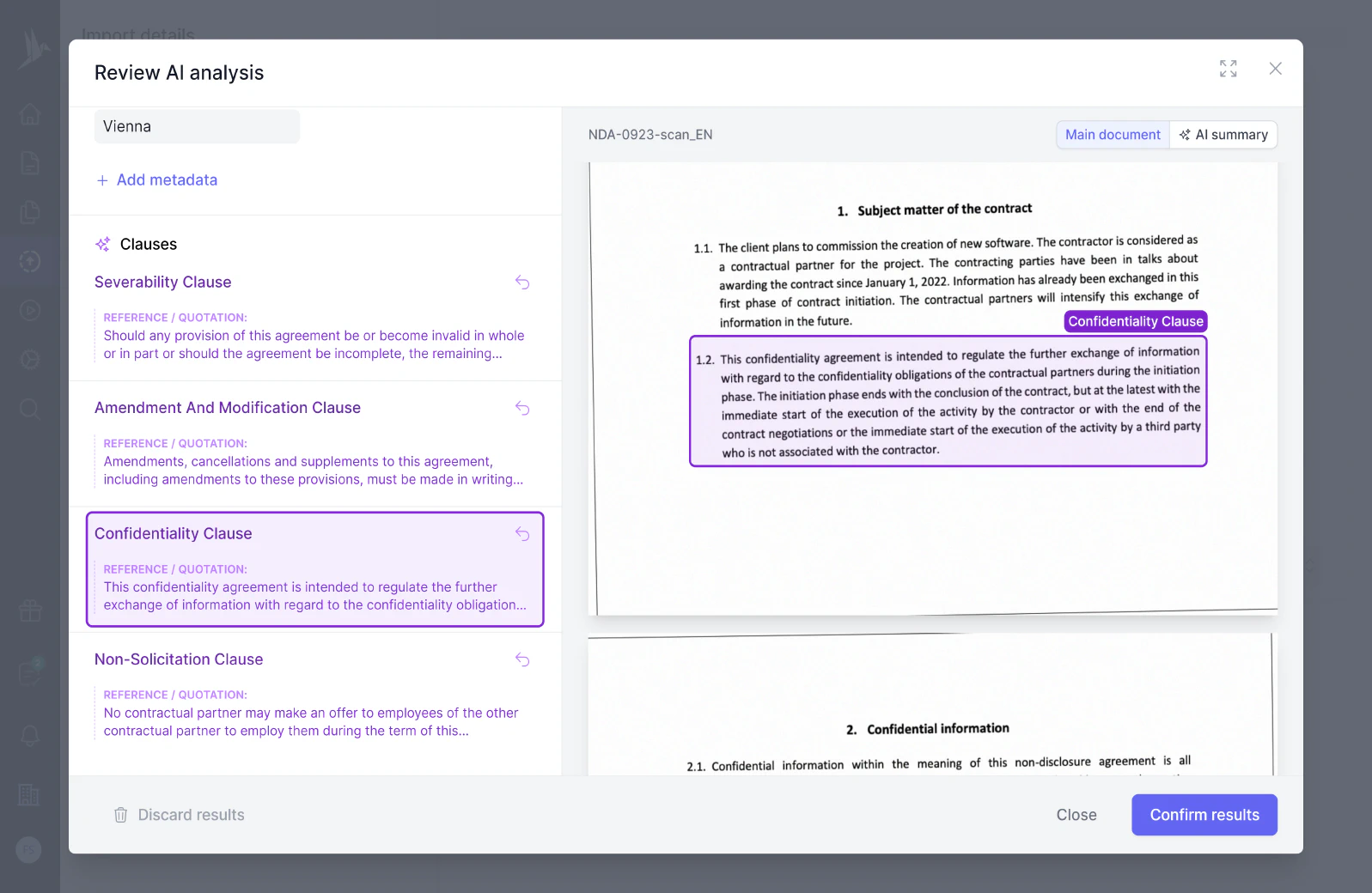
Energy Services Agreement Template
A clear energy services agreement template for engaging a service provider to manage operations, finance, and compliance.
The Confidential Information clause typically outlines obligations regarding the handling and protection of sensitive data shared between parties in a contract. It specifies what constitutes confidential information, the duration of confidentiality, and any exceptions to these terms, ensuring proprietary or private information is not disclosed to unauthorized third parties.
“Confidential Information” means all confidential or proprietary information of the Disclosing Party or its Affiliates, regardless of its form or medium as provided to the Receiving Party in connection with the Purpose; provided that, Confidential Information shall not include any information that the Receiving Party can show by competent evidence: (i) is already known to the Receiving Party at the time it is disclosed to the Receiving Party by the Disclosing Party free of any obligation of confidence to the Disclosing Party; (ii) is or becomes generally known to the public through no act or omission of the Receiving Party in violation of the terms of this Agreement; (iii) has been lawfully received by the Receiving Party from a third party, other than a Representative of the Disclosing Party, without restriction on its disclosure and without, to the knowledge of the Receiving Party, a breach by such third party of an obligation of confidentiality to the Disclosing Party; or (iv) has been independently developed by the Receiving Party without use of or reference to the Confidential Information.
“Confidential Information” shall mean any and all trade secrets, know-how or scientific, clinical, technical, financial, strategic or business information of Transferor or its Affiliates, whether proprietary or not, that are (A) disclosed or provided by or on behalf of the Transferor for the Purpose prior to, on, or after the Effective Date, whether disclosed (a) in written (or other tangible) form or equivalent, or (b) orally, visually, electronically or otherwise; or (B) accessed or developed by Recipient in the course of its activities or visits at Transferor’s facilities, or in the course of due diligence activities (including access to any data room made available by Transferor) and in each case, whether or not marked, designated, or otherwise identified as “confidential”.
Confidential Information: This includes but is not limited to any information, whether in oral or written form, complete or partial, original or copy, that is not publicly disclosed or made available by Party A or its Affiliates, such as: (1) Technical Confidential Information: Technical solutions, technical specifications, engineering designs, circuit designs, formula designs, manufacturing methods, process flows, improvements, drawings, samples, prototypes, models, molds, databases, systems, programs, operation manuals, experimental data, test results, test reports, technical documents, research and development records, technological development and innovation outcomes, and etc. (5) Other Confidential Information: Information belonging to third parties but for which Party A has undertaken a confidentiality obligation, matters for which Party A or its Affiliates are obligated to maintain confidentiality in accordance with legal regulations and relevant agreements, information for which Party A has implemented protective measures such as locking and encryption codes, information marked with confidentiality symbols on the medium, and other confidential information verbally or in writing declared and confirmed by both Party A and Party B.
For purposes of this Agreement, the term “Confidential Information” shall mean information that Santander owns or possesses, that Santander has developed, that it uses or that is potentially useful in the business of the Company, and/or that the Company treats as proprietary, private, or confidential. Confidential Information includes, but is not limited to, (a) inventions, ideas, processes, formulas, data, lists, programs, internal memos, other works of authorship, know-how, improvements, discoveries, trade secrets, developments, designs, and techniques relating to the business or proposed business of Santander; (b) information regarding plans for research, development, new products and services, marketing and selling, business plans, budgets and unpublished financial statements, licenses, prices and costs, suppliers, customer lists, cost structures, customer needs/preferences, the identity of Santander’s automotive dealer partners, and the terms of the relationship between Santander and the automotive dealerships; and (c) information regarding the skills and capabilities of other employees, consultants, vendors, and contractors for Santander that the Company desires to protect against disclosure or competitive use.
Confidential Information is and shall remain the sole property of the Disclosing Party. Each Party recognizes and agrees that nothing contained in this Agreement will be construed as granting the Receiving Party any property rights, by license or otherwise, to any Confidential Information of the Disclosing Party, or to any invention or any patent, copyright, trademark, or other intellectual property right that has issued or that may issue, based on such Confidential Information. Neither this Agreement nor the disclosure of any Confidential Information hereunder shall result in any obligation on the part of either Party to enter into any further agreement with the other, license any products or services to the other, or to require either Party to disclose any particular Confidential Information. Nothing in this Agreement creates or shall be deemed to create any employment, joint venture, or agency between the Parties.
Compulsory Disclosure of Confidential Information. If Investor or any of its Representatives is legally required in any judicial or administrative proceeding, or by any governmental or regulatory authority (whether by deposition, interrogatory, request for documents, subpoena, civil investigative demand or otherwise), or is otherwise legally required pursuant to applicable law or regulation (in each case if and as determined based on advice of Investor’s legal counsel), to disclose any Confidential Information, Investor or its Representatives, as applicable, shall (to the extent permissible under applicable law or the terms of such demand or request) give Holley prompt written notice of such request or requirement so that Holley may, at Investor’s sole expense, seek an appropriate protective order, and, upon Holley’s request and at Investor’s sole expense, shall provide reasonable cooperation to Holley in seeking such an order.
Return and Destruction of Confidential Information. Following the termination of this Agreement in accordance with its terms, the Investors shall promptly (and in no event later than ten business days after such request) at Investor’s option, either (x) return or cause to be returned to Holley, or (y) erase or destroy all copies of all Confidential Information in the possession or control of Investor or its Representatives (and certify to Holley such erasure or destruction). Notwithstanding anything to the contrary contained herein, Investor and its Representatives shall: (a) be permitted to retain copies of Confidential Information if such retention is required by law or regulation and (b) not be required to return or destroy Confidential Information that has been recorded as a result of such Investor’s firm-wide, automatic electronic archiving and back-up procedures; provided, that any copies of Confidential Information retained pursuant to this Section 4 shall only be accessed in order to comply with law or regulation or to prove compliance with this Agreement; provided, further, that, such Investor’s obligations hereunder to maintain the confidentiality of such retained Confidential Information shall survive the termination of this Agreement.
Confidential Information shall not include information which (i) is or becomes generally available to the public other than as a result of a disclosure by the Recipient or any Qualified Staff in violation of this Agreement, (ii) was available to the Receiving Party on a non-confidential basis from a source other than the Disclosing Party prior to the date hereof, (iii) becomes available to the Receiving Party subsequent to the date hereof from a third party who, to the Receiving Party’s knowledge, is lawfully in possession of such information and which information is not known by Receiving Party to be subject to any confidentiality agreements with Disclosing Party, or (iv) as shown by Receiving Party’s written records, is independently developed by the Receiving Party without use of or reference to the Confidential Information.
“Confidential Information” means all information, data, documents, agreements, files, and other materials (in any form or medium of communication, including whether disclosed orally or disclosed or stored in written, electronic, or other form or media) that is obtained from or disclosed by or on behalf of the Company or its Representatives, and obtained on or after the Effective Date, relating directly or indirectly to the Company or its businesses, affairs, assets, properties, or prospects, including, without limitation, all notes, analyses, compilations, reports, forecasts, data, studies, samples, interpretations, summaries, and other documents and materials (in any form or medium of communication, whether oral, written, electronic, or other form or media) prepared by or for Recipient to the extent that they contain or otherwise reflect or are derived from or based on such information, data, documents, agreements, files, or other materials. The term “Confidential Information” does not include information that: (i) at the time of disclosure is or thereafter becomes available to and known by the public (other than as a result of its disclosure directly or indirectly by Recipient or any of its Representatives in violation of this Agreement); (ii) was available to Recipient on a non-confidential basis from a source other than the Company or its Representatives, provided that, to Recipient’s knowledge after due inquiry, such source is not and was not bound by a confidentiality agreement with respect to such information or otherwise prohibited from transmitting such information by a contractual, legal, or fiduciary obligation; (iii) was or is already in the possession of Recipient or any of its Representatives prior to the time of disclosure by the Company, as shown by Recipient’s or such Representatives’ files and records and such information was not obtained, to Recipient’s knowledge after due inquiry, in violation of any obligation of confidentiality with respect to such information; or (iv) is independently developed by Recipient without reference to the Confidential Information and without violating any of its obligations under this Agreement, as shown by Recipient’s or such Representatives’ files and records.
Article III. Trade Secret Confidential Information. (a) Without limiting the foregoing obligations, and notwithstanding anything else to the contrary in this Agreement, Lilly shall not disclose Prevail Trade Secret Information to, or permit access to any Prevail Trade Secret Information by, any Representatives of Lilly, or any other individual or entity, except for the following individuals (only, in each case, if the individual is an employee of Lilly at the time of disclosure of the Prevail Trade Secret Information and has executed a valid and enforceable written joinder to this Agreement, a copy of which has been provided to Prevail): Luma Ibrahim Izzy, Derek M Gray, and Michael R De Felippis, Steven L Vogtman (each, a “Clean Team Member”).
The party receiving (“Receiving Party”) Confidential Information of the other party (“Disclosing Party”) will exercise at least the same degree of care with respect to the Disclosing Party’s Confidential Information that the Receiving Party exercises to protect its own Confidential Information, but in no event shall the Receiving Party use less than reasonable care. The Receiving Party will only use or reproduce the Disclosing Party’s Confidential Information to the extent necessary to enable the Receiving Party to fulfill its obligations under this Agreement. Further, the Receiving Party may disclose the Disclosing Party’s Confidential Information to the directors, officers and/or employees of Receiving Party who have a
Nonconfidential Information. Notwithstanding anything to the contrary herein, Receiving Party shall have no obligation to preserve the confidentiality of any Confidential Information which: (1) is or becomes publicly known (other than through unauthorized disclosure by the Disclosing Party) and is available to Receiving Party without use of or reference to any of Disclosing Party’s Confidential Information; (2) at the time of disclosure to Receiving Party, is already in the possession of or known to Receiving Party and is available to Receiving Party without use of or reference to any of Disclosing Party’s Confidential Information and is not subject to any other confidentiality undertaking; (3) is disclosed to Receiving Party by any person or entity other than Disclosing Party and is available to Receiving Party without use of or reference to any of Disclosing Party’s Confidential Information and is not subject to any other confidentiality undertaking; or (4) is developed by Receiving Party without use of or reference to any Confidential Information or any other information subject to a confidentiality undertaking.
Destruction of Confidential Information. At the request of the Disclosing Party, the Receiving Party shall destroy all originals, copies, and summaries of documents, materials, and other tangible manifestations of Confidential Information in the possession or control of the Receiving Party, except that the Receiving Party, subject to the obligations under this Agreement, (i) may retain one copy of the Confidential Information in a secure location for the sole purpose of monitoring its ongoing obligations in respect of such information and (ii) shall not be required to destroy any copies of Confidential Information that are securely stored in automated electronic backups.
Confidential information refers to data or details that are not generally known to the public and which a party wishes or is required to keep protected from disclosure. This information is often given legal protection through contracts, laws, or agreements. The nature of confidential information can vary widely, but generally, it encompasses sensitive business details, trade secrets, personal information, or proprietary knowledge.
Characteristics of confidential information include:
Examples of confidential information include:
- Trade secrets: Formulas, practices, processes, designs, instruments, or patterns used by a business to obtain an advantage over competitors.
- Business strategies and plans: Future marketing campaigns, product launches, or financial forecasts.
- Customer lists: Contact information and personal details about clients that are valuable for businesses.
- Legal agreements and contracts: Drafts or signed documents containing sensitive terms.
Confidential information should be used:
It is essential to identify what information requires confidentiality and ensure protective measures are in place before sharing it with other parties.
When documenting confidential information, it is crucial to:
Document templates for confidential information might start with a header reading:
“CONFIDENTIAL: The information contained in this document is confidential and proprietary to [Your Company Name]. Unauthorized disclosure, use, or reproduction of any part of this document may result in legal action.”
Contracts that typically involve or protect confidential information include:
These agreements often establish the obligations of the parties involved concerning the use and protection of confidential information.
These templates contain the clause you just read about.

A clear energy services agreement template for engaging a service provider to manage operations, finance, and compliance.

Define roles, compensation, and confidentiality between event organizers and companies for professional event execution.

Restrict competitive activities, protect confidential information, and enforce post-employment obligations with a customizable non-compete.

Download our proprietary information and inventions agreement (PIIA) to ensure the confidential information stays protected.

A work for hire agreement template that ensures ownership of creative works, designs, inventions, and intellectual property.
Dive deeper into the world of clauses and learn more about these other clauses that are used in real contracts.
A confidentiality clause is a provision in a contract that obligates one or both parties to keep certain information confidential and not to disclose it to third parties without prior consent. This clause is designed to protect sensitive information such as trade secrets, business strategies, and proprietary data shared during the course of the contractual relationship.
The confidentiality clause ensures that all documents and information exchanged between parties remain private and are not disclosed to unauthorized individuals or entities. This clause obligates the parties to implement appropriate measures to safeguard sensitive data, thereby protecting proprietary and personal information from unintended exposure or misuse.
A conflict of interest clause is designed to prevent situations where an individual's personal interests might interfere with their professional duties and responsibilities. It requires parties to disclose any potential conflicts and may set guidelines for managing or mitigating them to ensure ethical and impartial decision-making.
Try our AI contract analysis and extract important clauses and information from existing contracts.
< <
Fill out the form and we will get in touch with you to give you a personal, customized demo of fynk.
Greetings!
I'm Markus, co-founder of fynk. After you've submitted the form, I'll swiftly get in touch with you.
Also, right after you submit your details, you can pick a time that works best for you for our meeting.

